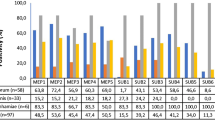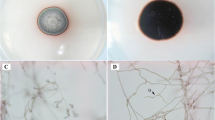Abstract
Epidermophyton floccosum is one of the most common agents of human superficial fungal infections, compared with genus Trichophyton and Microsporum, it possesses uniqueness in ecology traits and rarely causing hair infections. E. floccosum is so far the only representative species of genera Epidermophyton, and it is known as anthropophilic dermatophytes. To further reveal the genome sequences and clues of virulence factors, thus in this study, we sequenced the genome of E. floccosum (CGMCC (F) E1d), and performed comparative genomic analysis with other dermatophytes. It is revealed that E. floccosum owns the largest genome size and similar GC content compared with other dermatophytes. A total of 7565 genes are predicted. By comparing with the closest species N. gypseum, our study reveals that number and structure of adhesion factors, secreted proteases and LysM domain might contribute to the pathogenic and ecological traits of E. floccosum. Mating genes is also detected in genome data. Furthermore, we performed AFLP analysis trying to discuss intraspecific differences of E. floccosum, but no significant relationship is found between genotype and geographical distribution. Upon above, our study provides a deeper understanding and strong foundation for future researches about E. floccosum.






Similar content being viewed by others
References
de Hoog GS, Dukik K, Monod M, Packeu A, Stubbe D, Hendrickx M, et al. Toward a novel multilocus phylogenetic taxonomy for the dermatophytes. Mycopathologia. 2017;182(1–2):5–31. https://doi.org/10.1007/s11046-016-0073-9.
McCormack P, Benham RW. An unusual finding in Epidermophyton floccosum. J Investig Dermatol. 1952;19(5):315–7. https://doi.org/10.1038/jid.1952.104.
Cabañes FJ, Bragulat MR, Bruguera T, Abarca L. The growth of Epidermophyton floccosum and E. stockdaleae at different temperatures. Mycopathologia. 1990;112(3):157–63. https://doi.org/10.1007/bf00436647.
Cabañes FJ, Abarca L, Bragulat M, Bruguera T. Sensitivity of some strains of the genus Epidermophyton to different antifungal agents. Mycopathologia. 1989;105(3):153–6. https://doi.org/10.1007/bf00437247.
Zamani S, Sadeghi G, Yazdinia F, Moosa H, Pazooki A, Ghafarinia Z, et al. Epidemiological trends of dermatophytosis in Tehran, Iran: a five-year retrospective study. J Mycol Med. 2016;26(4):351–8. https://doi.org/10.1016/j.mycmed.2016.06.007.
Nweze EI, Eke IE. Dermatophytes and dermatophytosis in the eastern and southern parts of Africa. Med Mycol. 2018;56(1):13–28. https://doi.org/10.1093/mmy/myx025.
Qiangqiang Z, Limo Q, Qixian Q. Case report. Disseminated tinea of the verrucous type due to epidermophyton floccosum. Mycoses. 2001;44(7–8):326–9.
Mary ES, Mark GT. Invasive disease due to Epidermophyton floccosum in an immunocompromised patient with Behçet’s syndrome. Clinical infectious diseases: an official publication of the Infectious Diseases Society of America. 1997;25(1):153–4.
Rivera ZS, Losada L, Nierman WC. Back to the future for dermatophyte genomics. MBio. 2012. https://doi.org/10.1128/mBio.00381-12.
Burmester A, Shelest E, Glöckner G, Heddergott C, Schindler S, Staib P, et al. Comparative and functional genomics provide insights into the pathogenicity of dermatophytic fungi. Genome Biol. 2011;12(1):R7. https://doi.org/10.1186/gb-2011-12-1-r7.
Martinez DA, Oliver BG, Graser Y, Goldberg JM, Li W, Martinez-Rossi NM, et al. Comparative genome analysis of Trichophyton rubrum and related dermatophytes reveals candidate genes involved in infection. MBio. 2012;3(5):e00259-12. https://doi.org/10.1128/mBio.00259-12.
Zhan P, Dukik K, Li D, Sun J, Stielow JB, Gerrits van den Ende B, et al. Phylogeny of dermatophytes with genomic character evaluation of clinically distinct Trichophyton rubrum and T. violaceum. Stud Mycol. 2018;89:153–75. https://doi.org/10.1016/j.simyco.2018.02.004.
Hsueh YP, Heitman J. Orchestration of sexual reproduction and virulence by the fungal mating-type locus. Curr Opin Microbiol. 2008;11(6):517–24. https://doi.org/10.1016/j.mib.2008.09.014.
Metin B, Heitman J. Sexual reproduction in dermatophytes. Mycopathologia. 2017;182(1–2):45–55. https://doi.org/10.1007/s11046-016-0072-x.
Restrepo CM, Llanes A, Lleonart R. Use of AFLP for the study of eukaryotic pathogens affecting humans. Infect Genet Evol J Mol Epidemiol Evol Genet Infect Dis. 2018;63:360–9. https://doi.org/10.1016/j.meegid.2017.09.017.
Li L, Stoeckert CJ Jr, Roos DS. OrthoMCL: identification of ortholog groups for eukaryotic genomes. Genome Res. 2003;13(9):2178–89. https://doi.org/10.1101/gr.1224503.
Edgar RC. MUSCLE: multiple sequence alignment with high accuracy and high throughput. Nucleic Acids Res. 2004;32(5):1792–7. https://doi.org/10.1093/nar/gkh340.
Guindon S, Dufayard JF, Lefort V, Anisimova M, Hordijk W, Gascuel O. New algorithms and methods to estimate maximum-likelihood phylogenies: assessing the performance of PhyML 3.0. Syst Biol. 2010;59(3):307–21. https://doi.org/10.1093/sysbio/syq010.
Fu L, Niu B, Zhu Z, Wu S, Li W. CD-HIT: accelerated for clustering the next-generation sequencing data. Bioinformatics (Oxford, England). 2012;28(23):3150–2. https://doi.org/10.1093/bioinformatics/bts565.
Nielsen H. Predicting Secretory Proteins With SignalP. Methods Mol Biol (Clifton, NJ). 2017;1611:59–73. https://doi.org/10.1007/978-1-4939-7015-5_6.
Krogh A, Larsson B, von Heijne G, Sonnhammer EL. Predicting transmembrane protein topology with a hidden Markov model: application to complete genomes. J Mol Biol. 2001;305(3):567–80. https://doi.org/10.1006/jmbi.2000.4315.
Eisenhaber B, Schneider G, Wildpaner M, Eisenhaber F. A sensitive predictor for potential GPI lipid modification sites in fungal protein sequences and its application to genome-wide studies for Aspergillus nidulans, Candida albicans, Neurospora crassa, Saccharomyces cerevisiae and Schizosaccharomyces pombe. J Mol Biol. 2004;337(2):243–53. https://doi.org/10.1016/j.jmb.2004.01.025.
Mercer DK, Stewart CS. Keratin hydrolysis by dermatophytes. Med Mycol. 2019;57(1):13–22. https://doi.org/10.1093/mmy/myx160.
Makimura K, Murayama SY, Yamaguchi H. Detection of a wide range of medically important fungi by the polymerase chain reaction. J Med Microbiol. 1994;40(5):358–64. https://doi.org/10.1099/00222615-40-5-358.
Vos P, Hogers R, Bleeker M, Reijans M, van de Lee T, Hornes M, et al. AFLP: a new technique for DNA fingerprinting. Nucleic Acids Res. 1995;23(21):4407–14. https://doi.org/10.1093/nar/23.21.4407.
Gao Y, Zhan P, Hagen F, Menken SBJ, Sun J, Rezaei-Matehkolaei A, et al. Molecular epidemiology and in vitro antifungal susceptibility of Trichophyton schoenleinii, agent of tinea capitis favosa. Mycoses. 2019;62(5):466–74. https://doi.org/10.1111/myc.12889.
Kosanke S, Hamann L, Kupsch C, Moreno Garcia S, Chopra A, Gräser Y. Unequal distribution of the mating type (MAT) locus idiomorphs in dermatophyte species. Fungal Genet Biol FG B. 2018;118:45–53. https://doi.org/10.1016/j.fgb.2018.07.003.
Gastebois A, Fontaine T, Latgé JP, Mouyna I. beta(1–3)Glucanosyltransferase Gel4p is essential for Aspergillus fumigatus. Eukaryot Cell. 2010;9(8):1294–8. https://doi.org/10.1128/ec.00107-10.
Kamei M, Yamashita K, Takahashi M, Fukumori F, Ichiishi A, Fujimura M. Deletion and expression analysis of beta-(1,3)-glucanosyltransferase genes in Neurospora crassa. Fungal Genet Biol FG & B. 2013;52:65–72. https://doi.org/10.1016/j.fgb.2012.12.001.
Alshahni MM, Yamada T, Yo A, Murayama SY, Kuroda M, Hoshino Y, et al. Insight into the draft whole-genome sequence of the dermatophyte Arthroderma vanbreuseghemii. Sci Rep. 2018;8(1):15127. https://doi.org/10.1038/s41598-018-33505-9.
Muszewska A, Taylor JW, Szczesny P, Grynberg M. Independent subtilases expansions in fungi associated with animals. Mol Biol Evol. 2011;28(12):3395–404. https://doi.org/10.1093/molbev/msr176.
Chen J, Yi J, Liu L, Yin S, Chen R, Li M, et al. Substrate adaptation of Trichophyton rubrum secreted endoproteases. Microb Pathog. 2010;48(2):57–61. https://doi.org/10.1016/j.micpath.2009.12.001.
Descamps F, Brouta F, Monod M, Zaugg C, Baar D, Losson B, et al. Isolation of a Microsporum canis gene family encoding three subtilisin-like proteases expressed in vivo. J Investig Dermatol. 2002;119(4):830–5. https://doi.org/10.1046/j.1523-1747.2002.01784.x.
Baldo A, Mathy A, Tabart J, Camponova P, Vermout S, Massart L, et al. Secreted subtilisin Sub3 from Microsporum canis is required for adherence to but not for invasion of the epidermis. Br J Dermatol. 2010;162(5):990–7. https://doi.org/10.1111/j.1365-2133.2009.09608.x.
Bolton MD, van Esse HP, Vossen JH, de Jonge R, Stergiopoulos I, Stulemeijer IJ, et al. The novel Cladosporium fulvum lysin motif effector Ecp6 is a virulence factor with orthologues in other fungal species. Mol Microbiol. 2008;69(1):119–36. https://doi.org/10.1111/j.1365-2958.2008.06270.x.
de Jonge R, Thomma BP. Fungal LysM effectors: extinguishers of host immunity? Trends Microbiol. 2009;17(4):151–7. https://doi.org/10.1016/j.tim.2009.01.002.
Kar B, Patel P, Free SJ. Trichophyton rubrum LysM proteins bind to fungal cell wall chitin and to the N-linked oligosaccharides present on human skin glycoproteins. PLoS ONE. 2019;14(4):e0215034. https://doi.org/10.1371/journal.pone.0215034.
Persinoti GF, Martinez DA, Li W, Döğen A, Billmyre RB, Averette A, et al. Whole-genome analysis illustrates global clonal population structure of the ubiquitous dermatophyte pathogen Trichophyton rubrum. Genetics. 2018;208(4):1657–69. https://doi.org/10.1534/genetics.117.300573.
Ansari S, Ahmadi B, Norouzi M, Ansari Z, Afsarian MH, Lotfali E, et al. Epidermophyton floccosum: nucleotide sequence analysis and antifungal susceptibility testing of 40 clinical isolates. J Med Microbiol. 2019;68(11):1655–63. https://doi.org/10.1099/jmm.0.001074.
Khosravi A, Behzad F, Sabokbar A, Shokri H, Haddadi S, Masoudi-Nejad A. Molecular typing of Epidermophyton floccosum isolated from patients with dermatophytosis by RAPD-PCR. J Basic Microbiol. 2010;50(Suppl 1):S68-73. https://doi.org/10.1002/jobm.201000089.
De Baere T, Summerbell R, Theelen B, Boekhout T, Vaneechoutte M. Evaluation of internal transcribed spacer 2-RFLP analysis for the identification of dermatophytes. J Med Microbiol. 2010;59(Pt 1):48–54. https://doi.org/10.1099/jmm.0.013870-0.
Acknowledgements
This study was funded by The National Natural Science Foundation of China (No. 81972949), the Scientific and Technological Innovation Projects of Medicine and Health of Chinese Academy of Medical Sciences (No. 2016-I2M-3-021), the Nanjing Incubation Program for National Clinical Research Center (No. 2019060001) and the Basical Scientific Research Fund Projects of Chinese Academy of Medical Sciences (No. 2018PT31013).
Author information
Authors and Affiliations
Corresponding author
Ethics declarations
Conflict of interest
The authors declare that they have on conflict of interest.
Additional information
Handling Editor: Vishnu Chaturvedi
Publisher's Note
Springer Nature remains neutral with regard to jurisdictional claims in published maps and institutional affiliations.
Rights and permissions
About this article
Cite this article
Liu, J., Ge, L., Mei, H. et al. Comparative Genomics and Molecular Analysis of Epidermophyton floccosum. Mycopathologia 186, 487–497 (2021). https://doi.org/10.1007/s11046-021-00567-9
Received:
Accepted:
Published:
Issue Date:
DOI: https://doi.org/10.1007/s11046-021-00567-9




